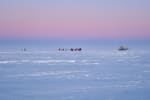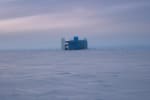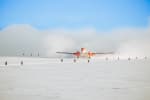Ahhh—the twilight sky! The sun has officially set, but the light lingers for some time afterward. At the South Pole, that period of lingering light last weeks rather than minutes or hours. And it really is something to behold, with the icy surface taking on shades of blue and blending into the sky above, itself […]
News
IceCube meets in Münster for its spring 2024 collaboration meeting
Over 250 participants took part in the spring IceCube Collaboration meeting, which wrapped up last week in Münster, Germany. Hosted by the University of Münster for the first time, the meeting ran from March 17 through March 22. Before the official start of the collaboration meeting, a number of pre-meetings were held to discuss the […]
Sanjib Kumar Agarwalla receives prestigious 2021-2022 Rajib Goyal Prize
Sanjib Kumar Agarwalla was recently awarded the 2021-2022 Rajib Goyal Prize in Physical Sciences, which “honors Indian scientists who have made a mark in basic and applied sciences research.” The Goyal Prizes were instituted by the late philanthropist Ram S. Goyal to honor Indian scientists and social activists working towards the service of India. Agarwalla […]
IceCube search for neutrino decoherence from quantum gravity
The unification of quantum theory and gravitation remains one of the most outstanding challenges in fundamental physics today. One mystery is the quantum nature of spacetime—a fusion of the three dimensions of space and the fourth dimension of time—and whether it is subject to the randomness seen in other quantum theories, resulting in fluctuations at […]
Week 11 at the Pole
It was another busy week at the Pole, with many trips out to the IceCube Lab (ICL) for IceCube’s winterovers. They had to do some detector maintenance and troubleshooting out at the ICL, but they also made the trek out to help others debug certain issues with the power supplies. Toward the end of the […]
2024 IceCube Impact Awards announced
The results of the eleventh edition of the IceCube Impact Awards were announced today during IceCube’s spring collaboration meeting dinner in Münster, Germany. During the ceremony, IceCube spokesperson Ignacio Taboada gave each recipient a certificate and mug to commemorate their achievements while those who could not attend joined virtually. The awardees are Lasse Halve (RWTH […]
Week 10 at the Pole
As the sun continues to lower at the South Pole, shadows lengthen and the sky gradually darkens. The station in general has been settling into its winter groove, with everyone “volunteering” in shared activities—dishpit, house mouse (cleaning), greenhouse checks, and trash collection—to keep things running smoothly throughout the winter. Last week, IceCube’s winterovers were also […]
Week 9 at the Pole
Some things are worth waiting for. And the live interview that was scheduled last week as part of the viewing of all three “The Thing” movies is one of them, as the special guest was none other than John Carpenter, director of 1982’s “The Thing.” The director discussed his work and how they tried to […]
IceCube observes seven astrophysical tau neutrino candidates
Neutrinos are tiny, weakly interacting subatomic particles that can travel astronomical distances undisturbed. As such, they can be traced back to their sources, revealing the mysteries surrounding the cosmos. High-energy neutrinos that originate from the farthest reaches beyond our galaxy are called astrophysical neutrinos and are the main subject of study for the IceCube Neutrino […]
Improving in-ice particle shower models for reconstruction of IceCube events
The IceCube neutrino detector, embedded in a cubic kilometer of Antarctic ice, searches for high-energy neutrinos from the farthest reaches of outer space. The pristine ice serves as a natural medium for detecting showers of secondary charged particles that result from many neutrino interaction types in the ice. Through a process called Cherenkov radiation, ultraviolet […]









